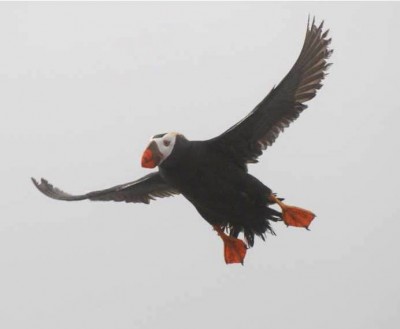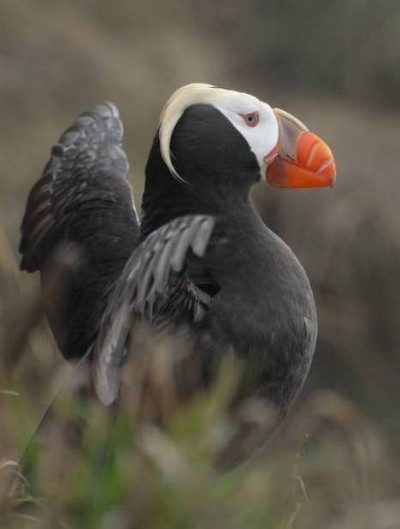TACOMA, Wash. – “It’s just hatched. You’re one of the few people in the world ever to see a Tufted Puffin chick in its burrow,” said Professor Peter Hodum to a writer for the national magazine BirdWatching, as the two men crouched on a 100-foot cliff. The writer had accompanied Hodum on an excursion to Tatoosh Island in Washington state to study the Tufted Puffin, an iconic bird that, for unknown reasons, has been disappearing from the West Coast of the United States.
Hodum, visiting assistant professor in biology at University of Puget Sound, and Scott Pearson, a research scientist for the Washington Department of Fish and Wildlife, have been studying the puffin since 2005. The cliff-nesting bird, with its thick orange beak and Einstein-like tufts of swept-back head feathers, is “woefully understudied,” Hodum told BirdWatching.
The two researchers are trying to understand why the species continues to flourish in Alaska and Russia, at the northern end of its breeding range, and yet, in the past decade or two, has been seen more rarely nesting on the U.S. West Coast, at the southern end of its distribution range.Tatoosh Island, off the Olympic Peninsula at the extreme northwest tip of the continental United States, is one of the few places on the Washington coast that the stocky black-and-white bird still appears in relatively large numbers. In the 1970s it was estimated that about 300 to 400 puffins nested on Tatoosh, the June issue of BirdWatching reported. The two scientists estimate that, more recently, the number has fallen to perhaps 50. A 1988 survey estimated about 5,000 puffins nested in Oregon. In 2008 a separate survey found just 148 of the birds, the magazine reported.
There are a number of possible causes of the decline, including a rising number of predators, such as Peregrine Falcons and Bald Eagles, as a result of successful conservation measures focused on those species. Changes in food availability as a result of fisheries may also be contributing. Or, more disturbingly, it could be that higher sea temperatures, related to global climate change, or increasing ocean acidity, caused by industrialization, are affecting their food supply and productivity.
The puffin study is part of a body of research on Washington island seabirds involving researchers from the Washington Department of Fish and Wildlife, University of Puget Sound, University of Washington, and the National Oceanic and Atmospheric Administration. The scientists are focused on the ecology and population dynamics of burrowing seabirds, principally Rhinoceros Auklets and Tufted Puffins.
The project is one of several Hodum has undertaken. He leads a research and conservation project on the Juan Fernández Islands off the coast of Chile, and he is a board member of Oikonos, a nonprofit group that directs conservation projects in California, the north Pacific, Chile, New Zealand, Mexico, and Antarctica. This summer he is doing research in Chile on a Fulbright grant.
The BirdWatching story, written by Charles Bergman, professor of English at Pacific Lutheran University in Tacoma, is available to the magazine’s subscribers at: BirdWatching/Puffins.
For more on Peter Hodum’s work visit: Peter Hodum’s faculty research page.
For details on other research undertaken by faculty in the Department of Biology visit: Biology/Faculty Research.
Photos on page: Tufted Puffins on Tatoosh Island, by Peter Hodum.
Follow us on Twitter! www.twitter.com/univpugetsound

